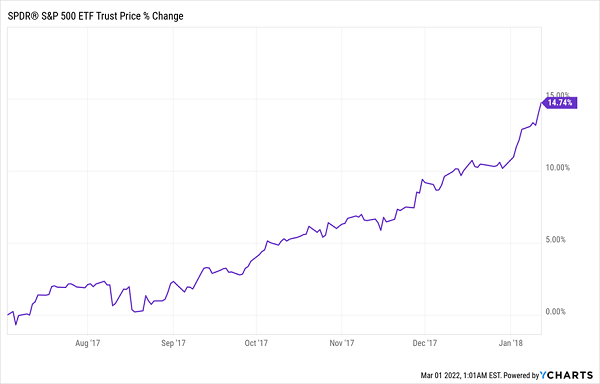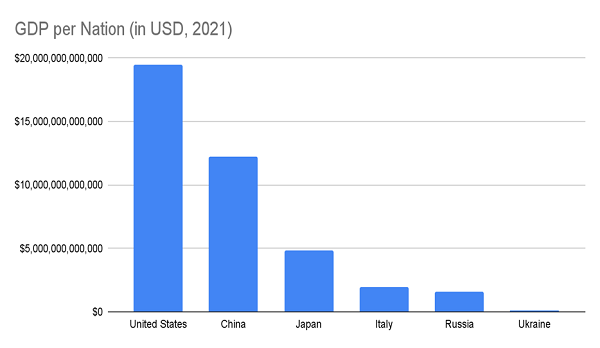These are trying times, so let’s talk about how we’re going to protect our retirement (and our families’ futures) as market volatility increases.
The Ukraine crisis is, of course, first and foremost a humanitarian tragedy the world is racing to respond to, as it should. It’s also being felt well beyond the borders of Russia and Ukraine, with rising energy prices fueling inflation fears, which are, in turn, causing panic in global markets.
High, Monthly CEF Dividends Help Stabilize Our Portfolios
At times like these, closed-end funds (CEFs) are a good investment choice because their high dividends help us meet our income needs while volatility increases: as I write this, our CEF Insider portfolio is delivering an 8% yield, on average, and we’re getting a predictable income stream, too, with 16 of our 21 holdings paying us monthly.
That gives us vital peace of mind in times like these. If you were a CEF Insider member in early 2020, you’ll remember that our CEF dividends were critical for us when the COVID-19 crisis hit, keeping our income stream coming while we got to the other side.
That’s one way our CEF portfolio helps us manage global shocks. Another can be found in the approach we follow: conservative income investors that we are, we’ve made sure to minimize any exposure to volatile parts of the world, like Russia.
Consider, for example, the Eaton Vance Tax Advantaged Global Dividend Income Fund (ETG), a portfolio recommendation that pays us every month and yields 8% as I write this.
ETG, like all of our equity CEFs, owns some of the biggest American companies, like Apple (AAPL), Microsoft (MSFT) and Chicago-based food maker Mondelez International (MDLZ). Beyond that, it holds a variety of steady international blue chips like Nestle SA (NSRGY). None of these steady consumer-focused names are likely to lose as a result of the Ukraine conflict, and ETG itself has no exposure to Russia or Ukraine.
History Holds an Important Investment Lesson
Those are just a couple of reasons why you should rest easy if you hold our CEF Insider portfolio picks. Another is history. Let’s go back to the most recent time war was a real threat: in mid-2017, when North Korea tested missiles that could deliver nuclear warheads to America’s shores.
Sure, war didn’t actually break out, but it sure felt close, especially if you lived in Hawaii, where in 2018 a false alarm about a missile strike panicked residents. How did stocks do? From the first test to the ninth in the six months that followed, they gained ground.
Stocks Pushed Higher in the Last Geopolitical Crisis

There have been similar rallies during the Cuban missile crisis in 1962 and at points in the 1970s and 1980s, too, again proving the point that geopolitical risks like the Ukraine situation tend to have a short-term impact on the market.
Economic Shock Could Bring Positive Changes
Another thing to bear in mind is that, from an economic perspective, this crisis is simply not that big.

Source: CEF Insider
Russia’s economy is smaller than that of Italy, while Ukraine is tiny, which means that what is really at stake is a small sliver of the world, economically speaking. And while it is true that Germany in particular is dependent on Russian energy, that dependence is not really shared by the rest of Europe (France, for instance, depends more on nuclear power).
And while we have seen oil prices spike past $100 a barrel, it’s important to remember that the majority of the rise in oil prices came long before the Ukraine conflict—other forces are much more important here. Furthermore, a possible nuclear-arms agreement with Iran could see that country’s production come back online soon. And countries across the globe have also said they’ll tap their strategic oil reserves in a bid to cushion the blow of high prices.
And let’s not forget the old adage: the cure for high prices is high prices. As interest rates rise and people’s pandemic savings get used up, demand should slow, just as production swells. That, in turn, should pull oil prices back to earth.
Our Defensive Strategy
So what’s our strategy here? Simple: we’ll do the same thing we’ve always done: keep collecting our high (and mostly monthly) CEF Insider dividends and stay with our conservative income-focused principles.
That means investing in the countries best positioned to weather the crisis and continue to post strong growth—starting with the US. ETG is a good place to start, with 46% of its investments in American companies and 54% spread across multinationals from other reliable global economies. There are plenty of other CEFs out there with this same mix.
A 4-Fund Portfolio Yielding 7.5% (and Built to Withstand a Market Shock)
I’ve assembled a 4-CEF portfolio yielding an outsized 7.5% that’s built for all market weather: you can simply buy these 4 funds, tuck them away and pocket their huge payouts.
Their big, steady dividends are a big part of their appeal, but they’re just the start: these funds also trade at discounts that I expect to disappear imminently, with price gains of 20%+ potentially in the offing here.
Plus, this portfolio is well-diversified: you’re getting funds holding utility stocks, real estate investment trusts (REITs), the best corporate bonds and convertible bonds—”chameleon” securities that let management flip from being a bond holder to a shareholder, and grab extra upside in the process.
Full details on this 4-CEF “mini-portfolio” are waiting for you now. Click here and I’ll give you these funds’ names, tickers, current yields, discounts, best-buy prices and everything else you need to know.
